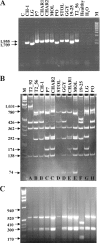Striking diversity of vmp1, a variable gene encoding a putative membrane protein of the stolbur phytoplasma
- PMID: 19270150
- PMCID: PMC2681707
- DOI: 10.1128/AEM.02613-08
Striking diversity of vmp1, a variable gene encoding a putative membrane protein of the stolbur phytoplasma
Abstract
Studies of phytoplasma-insect vector interactions and epidemiological surveys of plant yellows associated with the stolbur phytoplasma (StolP) require the identification of relevant candidate genes and typing markers. A recent StolP genome survey identified a partial coding sequence, SR01H10, having no homologue in the "Candidatus Phytoplasma asteris" genome but sharing low similarity with a variable surface protein of animal mycoplasmas. The complete coding sequence and its genetic environment have been fully characterized by chromosome walking. The vmp1 gene encodes a protein of 557 amino acids predicted to possess a putative signal peptide and a potential C-terminal transmembrane domain. The mature 57.8-kDa VMP1 protein is likely to be anchored in the phytoplasma membrane with a large N-terminal hydrophilic part exposed to the phytoplasma cell surface. Southern blotting experiments detected multiple sequences homologous to vmp1 in the genomes of nine StolP isolates. vmp1 is variable in size, and eight different vmp1 RsaI restriction fragment length polymorphism types could be distinguished among 12 StolP isolates. Comparison of vmp1 sequences revealed that insertions in largest forms of the gene encode an additional copy of a repeated domain of 81 amino acids, while variations in 11-bp repeats led to gene disruption in two StolP isolates. vmp1 appeared to be much more variable than three housekeeping genes involved in protein translation, maturation, and secretion and may therefore be involved in phytoplasma-host interactions.
Figures




References
-
- Arocha, Y., M. Lopez, M. Fernandez, B. Pinol, D. Horta, E. L. Peralta, R. Almeida, O. Carvajal, S. Picornell, M. R. Wilson, and P. Jones. 2005. Transmission of a sugarcane yellow leaf phytoplasma by the delphacid planthopper Saccharosydne saccharivora, a new vector of sugarcane yellow leaf syndrome. Plant Pathol. 54:634-642.
-
- Bai, X. D., J. H. Zhang, A. Ewing, S. A. Miller, A. J. Radek, D. V. Shevchenko, K. Tsukerman, T. Walunas, A. Lapidus, J. W. Campbell, and S. A. Hogenhout. 2006. Living with genome instability: the adaptation of phytoplasmas to diverse environments of their insect and plant hosts. J. Bacteriol. 188:3682-3696. - PMC - PubMed
-
- Berg, M., U. Melcher, and J. Fletcher. 2001. Characterization of Spiroplasma citri adhesion related protein SARP1, which contains a domain of a novel family designated sarpin. Gene 275:57-64. - PubMed
-
- Bressan, A., O. Semetey, B. Nusillard, D. Clair, and E. Boudon-Padieu. 2008. Insect vectors (Hemiptera: Cixiidae) and pathogens associated with the disease syndrome “basses richesses” of sugar beet in France. Plant Dis. 92:113-119. - PubMed
-
- Bressan, A., R. Turata, M. Maixner, S. Spiazzi, E. Boudon-Padieu, and V. Girolami. 2007. Vector activity of Hyalesthes obsoletus living on nettles and transmitting a stolbur phytoplasma to grapevines: a case study. Ann. Appl. Biol. 150:331-339.
Publication types
MeSH terms
Substances
Associated data
- Actions
- Actions
- Actions
- Actions
- Actions
- Actions
- Actions
- Actions
- Actions
- Actions
- Actions
- Actions
- Actions
LinkOut - more resources
Full Text Sources
Other Literature Sources

